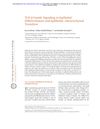Search
for
Did you mean TGF-β signaling pathway?
Learn
3 / 3 resultslearn Follistatin
glycoprotein that inhibits TGF-β and promotes hair growth by antagonizing activin
learn Procyanidin
bioflavonoid found in plants with antioxidant and hair stimulating properties
Research
5 / 1000+ results
research TGF-β Signaling During the Early Phase of Regeneration Is Required for Wound-Induced Hair Follicle Neogenesis
TGF-β signaling is essential for new hair growth after a wound.

research TGF-β Family Signaling in Epithelial Differentiation and Epithelial-Mesenchymal Transition
The TGF-β family helps control how cells change and move, affecting skin, hair, and organ development.
research TGFβ Signaling Regulates Lipogenesis in Human Sebaceous Gland Cells
TGFβ signaling prevents sebaceous gland cells from producing fats.

research Effects of Photobiomodulation at Various Irradiances on Normal and Dihydrotestosterone-Treated Human Hair Dermal Papilla Cells In Vitro
Red light at 8 mW/cm2 most effectively promotes hair cell growth and affects key growth pathways, especially in cells treated with a hair loss-related hormone.

research Transforming Growth Factor-Beta in Stem Cells and Tissue Homeostasis
TGF-β is crucial for tissue repair and can cause diseases if not properly regulated.
Community Join
5 / 67 results
community Compressed part of research of theory of androgenic/anabolitic balance. AGA h-responders analytic. Theory of physio-metabolitic method of anti AGA treatment
The treatment for androgenetic alopecia involves using finasteride and minoxidil with intense exercise and cold exposure to boost metabolism and reduce androgenic effects, potentially leading to hair regrowth. This approach may activate biological pathways for improved hair and overall health.
community A meta analysis of 18 popular hair loss treatments. An 2022 guide on efficacy. From finasteride and minoxidil to caffeine shampoo, saw palmetto and biotin. 96 Scientific References included.
Most hair loss treatments are ineffective; only finasteride, dutasteride, and minoxidil show effectiveness.
community Natural Remedies: Polyphenols and Hair Loss
Natural remedies to treat hair loss, such as polyphenols, apple peel extract, grape seed extract, green tea extract, peppermint oil, pumpkin seed oil, apigenin, Ginkgo biloba, red clover extract, olive leaf extract, Ecklonia Cava and Grateloupia elliptica. In addition, terpenes, carotenoids, and tocopherols were discussed as potential treatments.
community So we have 20k dollars human like machines available but no new effective treatment for hairloss since finasteride :)
There have been no new effective hair loss treatments since finasteride, despite technological advancements. Current treatments include finasteride, minoxidil, and RU58841, with ongoing challenges and potential future solutions in research.
community The Real Cause Of Androgenetic Alopecia
Androgenetic alopecia is caused by DHT affecting hair growth. Finasteride and minoxidil are used to manage hair loss by blocking DHT and promoting hair growth.